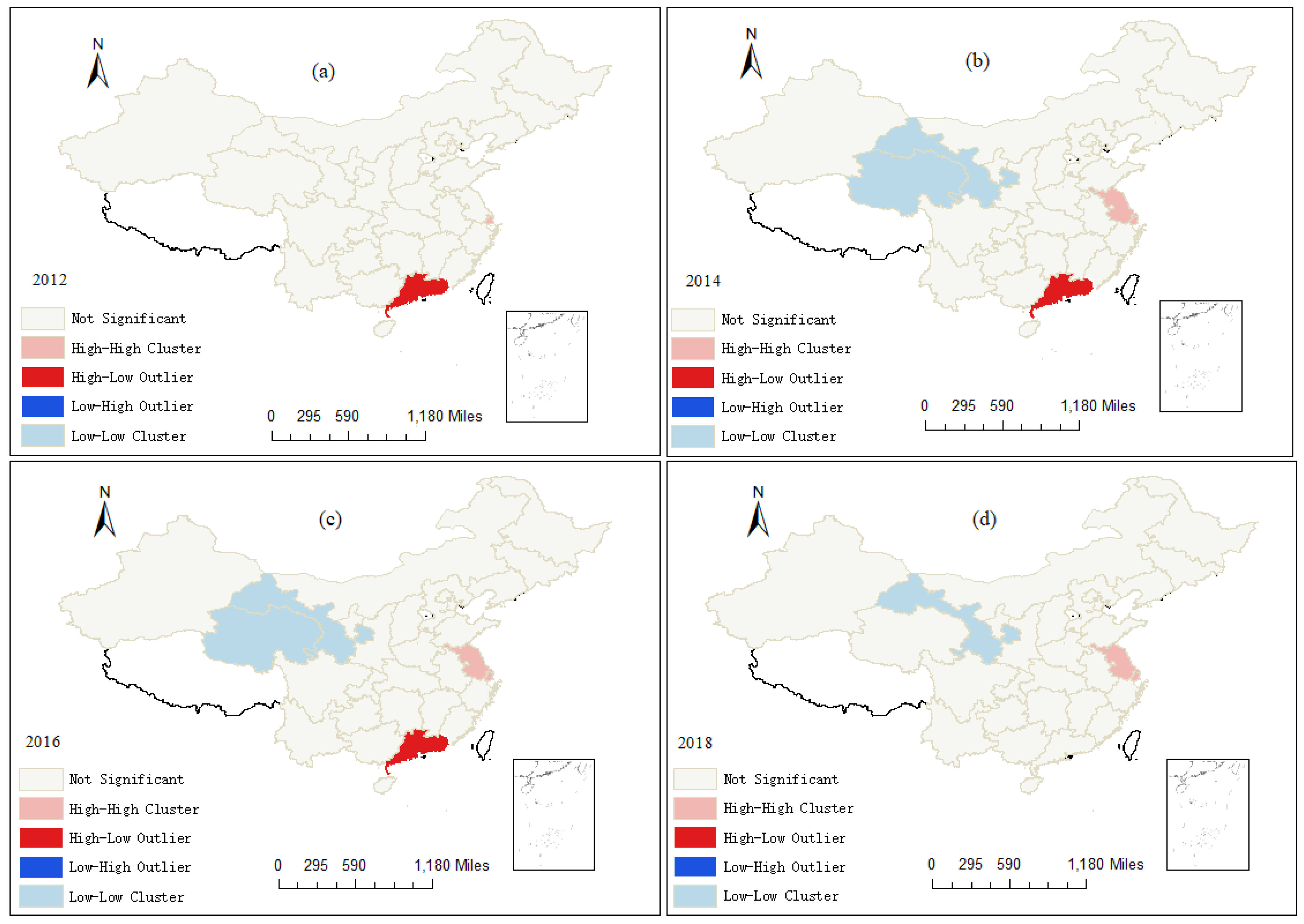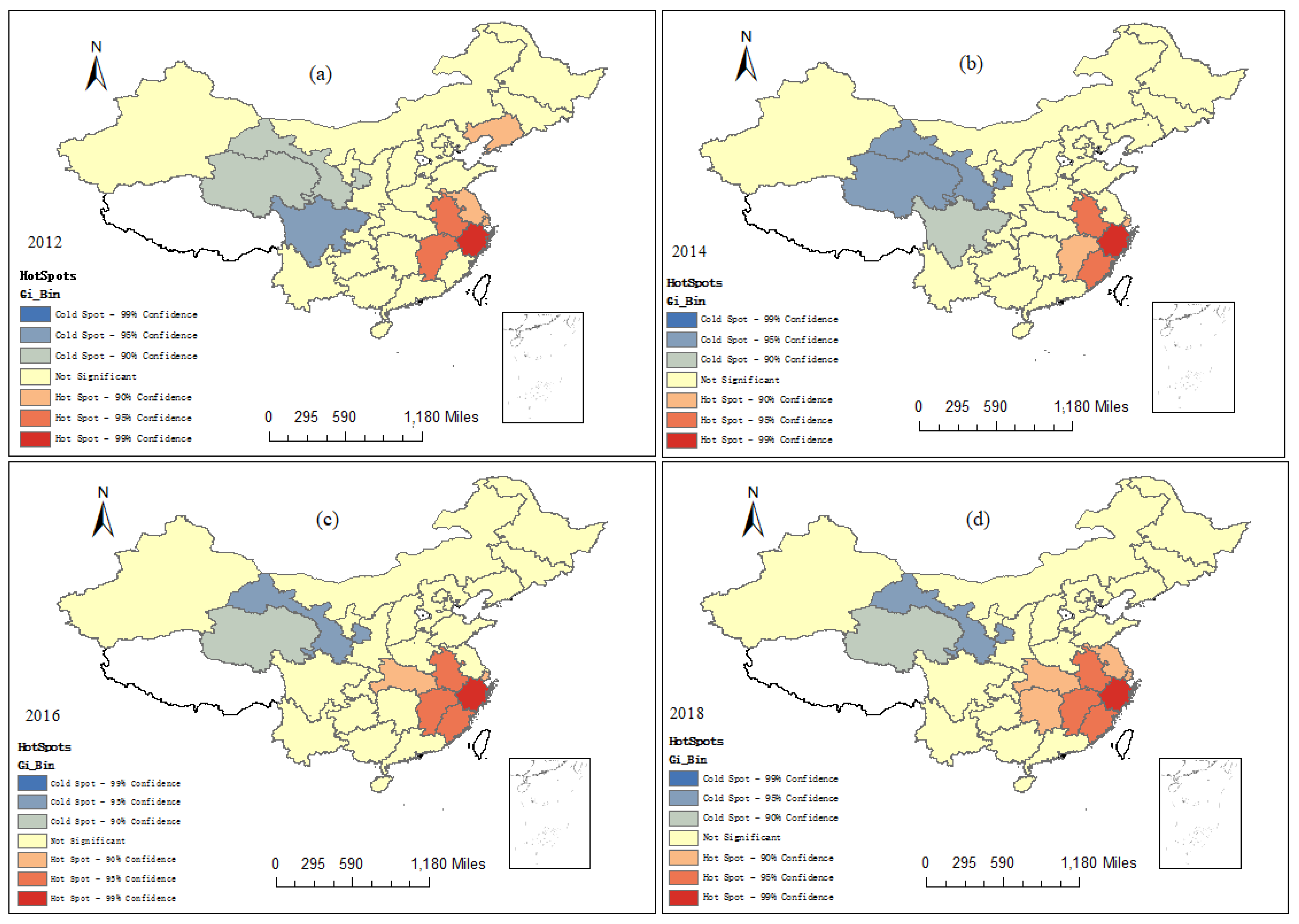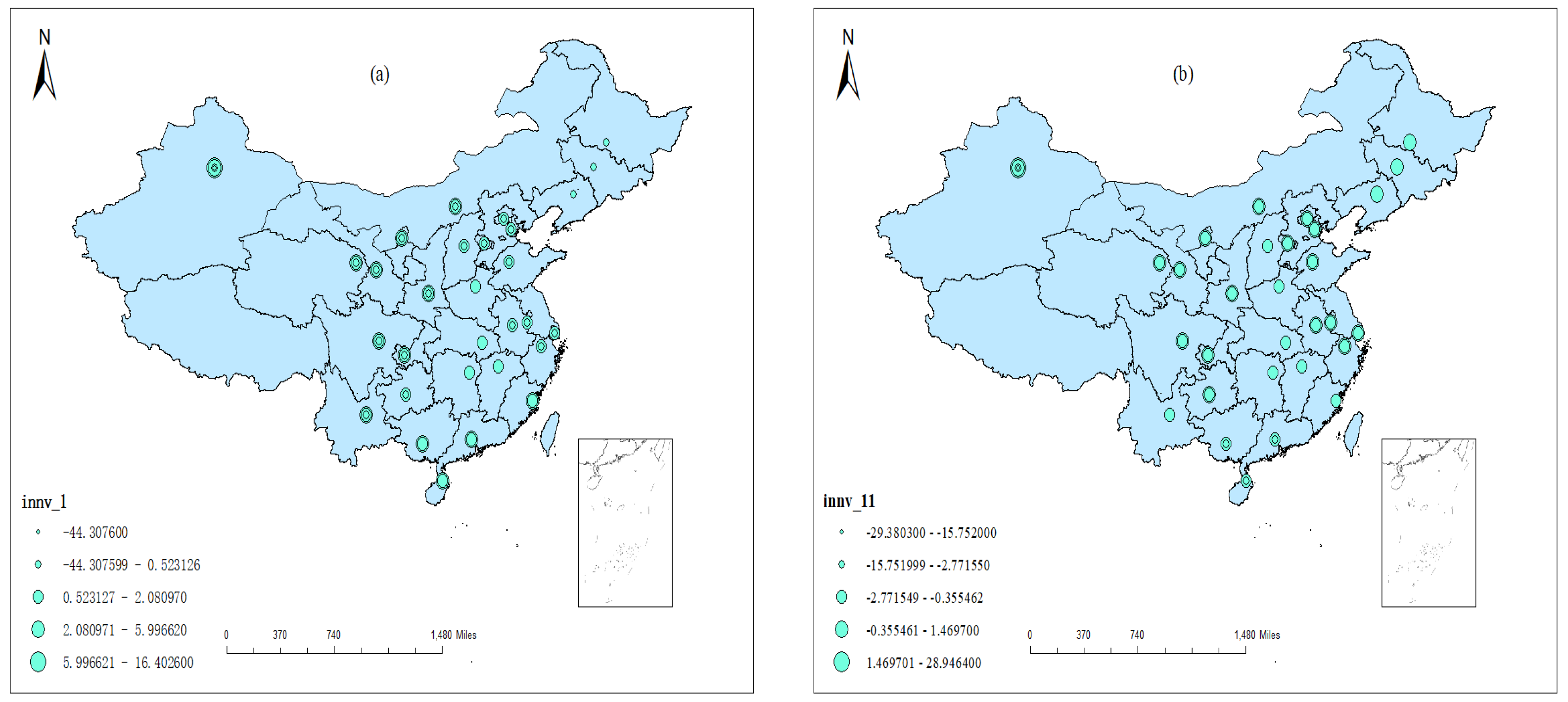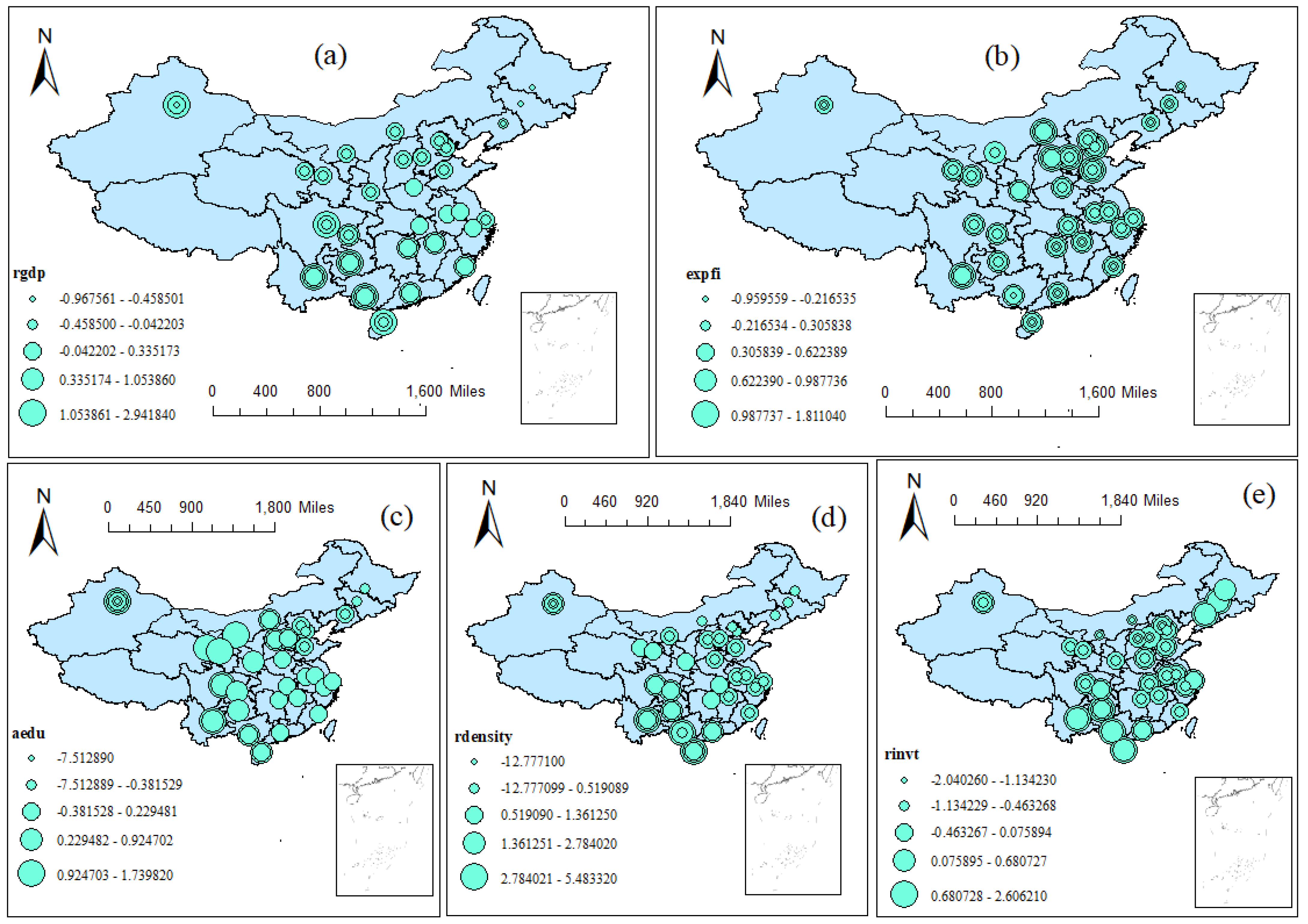The Carbon Emission Reduction Effect of Technological Innovation on the Transportation Industry and Its Spatial Heterogeneity: Evidence from China
Abstract
:1. Introduction
2. Literature Review
3. Methodology
3.1. The Spatial Relationship Analysis Model
3.2. The Spatiotemporal Heterogeneity Analysis Model
3.3. Variable Definition
3.3.1. The Dependent Variable
3.3.2. The Core Variable
3.3.3. The Control Variable
- (1)
- GDP per capita (rgdp). The increase in the GDP per capita is often accompanied by a higher transportation intensity, and the higher transportation intensity will lead to a growth in carbon emission per capita [36].
- (2)
- The proportion of fiscal expenditure on the transportation industry (expfi). From the beginning of the “13th Five-Year Plan” period, China has been promoting the green development of the transportation industry, and the fiscal expenditure in the transportation industry can encourage a low-carbon and intelligent transportation, combined with the transportation tax policy.
- (3)
- Higher education level (aedu). The level of higher education represents the regional technological innovation ability. The stronger the technological innovation ability, the more technological innovation achievements in the transportation industry, especially in terms of new energy vehicles, energy saving, and emission reduction which can significantly reduce the carbon emission in the transportation industry [37]. Referring to Wu, N. and Z. Liu. (2021) [38], the regional higher education level is represented by the students of local colleges and universities.
- (4)
- Population density (rdensity). The higher population density, the higher transportation demand, the stronger the transportation density, and the more carbon emission can be generated [39]. Since the city population density can only represent the urban population but not the rural population, in order to reflect the provincial population density, this article adopts the ratio of the total population to the area of the region to represent the population density.
- (5)
- The proportion of fixed assets investment in the transportation industry (rinvt). The proportion of fixed assets investment in the transportation industry is mainly used to measure the degree of fixed assets investment in the transportation industry. The fixed assets investment in the transportation industry is mainly used in the construction of road, railway, bridge and other attachments. There is a higher proportion of the fixed assets investment in the transportation industry currently on the road construction in China [40], and the higher the fixed assets investment in the transportation industry, the longer the road mileage, and the more potential of carbon emission in the transportation industry.
3.4. The Data Resources
4. Results
4.1. The Overall Trend of the Carbon Emission Level of China’s Transportation Industry
4.2. Spatial Local Autocorrelation Analysis
4.3. The Stableness Result of GTWR Model Estimation
4.4. The Empirical Result Analysis
4.4.1. The Impact of Technological Innovation
4.4.2. The Impact of Other Factors
5. Discussion
6. Conclusions and Policy Implications
Author Contributions
Funding
Institutional Review Board Statement
Informed Consent Statement
Data Availability Statement
Conflicts of Interest
References
- Zhou, Y.; Fang, W.; Li, M.; Liu, W. Exploring the impacts of a low-carbon policy instrument: A case of carbon tax on transportation in China. Resour. Conserv. Recycl. 2018, 139, 307–314. [Google Scholar] [CrossRef]
- Zhang, J.; Jin, W.; Philbin, S.; Lu, Q.-C.; Ballesteros-Pérez, P.; Skitmore, M.; Li, H. Impact of Environmental Regulations on Carbon Emissions of Transportation Infrastructure: China’s Evidence. Clean. Responsible Consum. 2021, 2, 100010. [Google Scholar] [CrossRef]
- Lu, S.; Jiang, H.; Liu, Y.; Huang, S. Regional disparities and influencing factors of Average CO 2 Emissions from transportation industry in Yangtze River Economic Belt. Transp. Res. Part D Transp. Environ. 2017, 57, 112–123. [Google Scholar] [CrossRef]
- Liu, M.; Zhang, X.; Zhang, M.; Feng, Y.; Liu, Y.; Wen, J.; Liu, L. Influencing factors of carbon emissions in transportation industry based on CD function and LMDI decomposition model: China as an example. Environ. Impact Assess. Rev. 2021, 90, 106623. [Google Scholar] [CrossRef]
- Zhang, N.; Wei, X. Dynamic total factor carbon emissions performance changes in the Chinese transportation industry. Appl. Energy 2015, 146, 409–420. [Google Scholar] [CrossRef]
- Danish; Ulucak, R. Renewable energy, technological innovation and the environment: A novel dynamic auto-regressive distributive lag simulation. Renew. Sustain. Energy Rev. 2021, 150, 111433. [Google Scholar] [CrossRef]
- Ali, S.A.; Alharthi, M.; Hussain, H.I.; Rasul, F.; Hanif, I.; Haider, J.; Ullah, S.; ur Rahman, S.; Abbas, Q. A clean technological innovation and eco-efficiency enhancement: A multi-index assessment of sustainable economic and environmental management. Technol. Forecast. Soc. Chang. 2021, 166, 120573. [Google Scholar] [CrossRef]
- Ma, Q.; Murshed, M.; Khan, Z. The nexuses between energy investments, technological innovations, emission taxes, and carbon emissions in China. Energy Policy 2021, 155, 112345. [Google Scholar] [CrossRef]
- Khan, Z.; Malik, M.Y.; Latif, K.; Jiao, Z. Heterogeneous effect of eco-innovation and human capital on renewable & non-renewable energy consumption: Disaggregate analysis for G-7 countries. Energy 2020, 209, 118405. [Google Scholar] [CrossRef]
- Zhang, J.; Chang, Y.; Zhang, L.; Li, D. Do technological innovations promote urban green development?—A spatial econometric analysis of 105 cities in China. J. Clean. Prod. 2018, 182, 395–403. [Google Scholar] [CrossRef]
- Zhang, Y.-J.; Jiang, L.; Shi, W. Exploring the growth-adjusted energy-emission efficiency of transportation industry in China. Energy Econ. 2020, 90, 104873. [Google Scholar] [CrossRef]
- Dong, F.; Yu, B.; Hadachin, T.; Yuanju, D.; Wang, Y.; Zhang, S.; Long, R. Drivers of carbon emission intensity change in China. Resour. Conserv. Recycl. 2018, 129, 187–201. [Google Scholar] [CrossRef]
- Ma, Q.; Jia, P.; Kuang, H. Green efficiency changes of comprehensive transportation in China: Technological change or technical efficiency change? J. Clean. Prod. 2021, 304, 127115. [Google Scholar] [CrossRef]
- Yu, Y.; Li, S.; Sun, H.; Taghizadeh-Hesary, F. Energy carbon emission reduction of China’s transportation sector: An input–output approach. Econ. Anal. Policy 2021, 69, 378–393. [Google Scholar] [CrossRef]
- Bach, H.; Bergek, A.; Bjørgum, Ø.; Hansen, T.; Kenzhegaliyeva, A.; Steen, M. Implementing maritime battery-electric and hydrogen solutions: A technological innovation systems analysis. Transp. Res. Part D Transp. Environ. 2020, 87, 102492. [Google Scholar] [CrossRef]
- Fan, Y.; Peng, B.-B.; Xu, J.-H. The effect of technology adoption on CO2 abatement costs under uncertainty in China’s passenger car sector. J. Clean. Prod. 2017, 154, 578–592. [Google Scholar] [CrossRef]
- Dillman, K.; Czepkiewicz, M.; Heinonen, J.; Fazeli, R.; Davidsdottir, B.; Shafiei, E. Decarbonization scenarios for Reykjavik’s passenger transport: The combined effects of behavioural changes and technological developments. Sustain. Cities Soc. 2020, 65, 102614. [Google Scholar] [CrossRef]
- Haftor, D.M.; Climent, R.C. CO2 reduction through digital transformation in long-haul transportation: Institutional entrepreneurship to unlock product-service system innovation. Ind. Mark. Manag. 2021, 94, 115–127. [Google Scholar] [CrossRef]
- Li, B.; Ma, Z.; Hidalgo-Gonzalez, P.; Lathem, A.; Fedorova, N.; He, G.; Zhong, H.; Chen, M.; Kammen, D. Modeling the impact of EVs in the Chinese power system: Pathways for implementing emissions reduction commitments in the power and transportation sectors. Energy Policy 2021, 149, 111962. [Google Scholar] [CrossRef]
- Zhao, J.; Xi, X.; Na, Q.; Wang, S.; Kadry, S.N.; Kumar, M.P. The technological innovation of hybrid and plug-in electric vehicles for environment carbon pollution control. Environ. Impact Assess. Rev. 2021, 86, 106506. [Google Scholar] [CrossRef]
- Yang, X.; Lin, S.; Li, Y.; He, M. Can high-speed rail reduce environmental pollution? Evidence from China. J. Clean. Prod. 2019, 239, 118135. [Google Scholar] [CrossRef]
- Sun, X.; Yan, S.; Liu, T.; Wu, J. High-speed rail development and urban environmental efficiency in China: A city-level examination. Transp. Res. Part D Transp. Environ. 2020, 86, 102456. [Google Scholar] [CrossRef]
- Jia, R.; Shao, S.; Yang, L. High-speed rail and CO2 emissions in urban China: A spatial difference-in-differences approach. Energy Econ. 2021, 99, 105271. [Google Scholar] [CrossRef]
- Erdoğan, S.; Yıldırım, S.; Yıldırım, D.Ç.; Gedikli, A. The effects of innovation on sectoral carbon emissions: Evidence from G20 countries. J. Environ. Manag. 2020, 267, 110637. [Google Scholar] [CrossRef]
- Liu, Y.; Li, Z.; Yin, X. Environmental regulation, technological innovation and energy consumption—A cross-region analysis in China. J. Clean. Prod. 2018, 203, 885–897. [Google Scholar] [CrossRef]
- Zhang, C.; Nian, J. Panel estimation for transport sector CO2 emissions and its affecting factors: A regional analysis in China. Energy Policy 2013, 63, 918–926. [Google Scholar] [CrossRef]
- Ye, L.; Xie, N.; Hu, A. A novel time-delay multivariate grey model for impact analysis of CO2 emissions from China’s transportation sectors. Appl. Math. Model. 2020, 91, 493–507. [Google Scholar] [CrossRef]
- Bai, C.; Zhou, L.; Minle, X.; Feng, C. Analysis of the spatial association network structure of China’s transportation carbon emissions and its driving factors. J. Environ. Manag. 2019, 253, 109765. [Google Scholar] [CrossRef]
- Liu, C.; Li, W.; Wang, W.; Zhou, H.; Liang, T.; Hou, F.; Xu, J.; Xue, P. Quantitative spatial analysis of vegetation dynamics and potential driving factors in a typical alpine region on the northeastern Tibetan Plateau using the Google Earth Engine. Catena 2021, 206, 105500. [Google Scholar] [CrossRef]
- Chao, W.; Wood, J.; Wang, Y.; Geng, X.; Long, X. CO2 emission in transportation sector across 51 countries along the Belt and Road from 2000 to 2014. J. Clean. Prod. 2020, 266, 122000. [Google Scholar] [CrossRef]
- Catchpole, S.; Rivera, R.; Hernández, C.; De la Peña, J.; González, P. Predicting spatial distribution patterns and hotspots of fish assemblage in a coastal basin of the central-south of Chile, by geostatistical techniques. J. Limnol. 2019, 78. [Google Scholar] [CrossRef] [Green Version]
- Huang, B.; Wu, B.; Barry, M. Geographically and Temporally Weighted Regression for Modeling Spatio-Temporal Variation in House Prices. Int. J. Geogr. Inf. Sci. 2010, 24, 383–401. [Google Scholar] [CrossRef]
- Shi, T.; Zhang, W.; Zhou, Q.; Wang, K. Industrial structure, urban governance and haze pollution: Spatiotemporal evidence from China. Sci. Total Environ. 2020, 742, 139228. [Google Scholar] [CrossRef] [PubMed]
- Brunsdon, C.; Fotheringham, A.; Charlton, M. Geographically Weighted Summary Statistics—A Framework for Localised Exploratory Data Analysis. Comput. Environ. Urban Syst. 2002, 26, 501–524. [Google Scholar] [CrossRef] [Green Version]
- Xie, R.; Wei, D.; Han, F.; Lu, Y.; Fang, J.; Yu, L.; Wang, J. The effect of traffic density on smog pollution: Evidence from Chinese cities. Technol. Forecast. Soc. Chang. 2018, 144, 421–427. [Google Scholar] [CrossRef]
- Zaekhan, Z.; Nachrowi, N. The lmpact of Renewable Energy and GDP per Capita on Carbon Dioxide Emission in the G-20 Countries. Econ. Financ. Indones. 2015, 60, 145. [Google Scholar] [CrossRef]
- Wang, L.; Zhao, Z.; Wang, X.; Xue, X. Transportation de-carbonization pathways and effect in China: A systematic analysis using STIRPAT-SD model. J. Clean. Prod. 2020, 288, 125574. [Google Scholar] [CrossRef]
- Wu, N.; Liu, Z. Higher education development, technological innovation and industrial structure upgrade. Technol. Forecast. Soc. Chang. 2021, 162, 120400. [Google Scholar] [CrossRef]
- Wu, J.; Wu, Y.; Guo, X. Urban Density and Carbon Emissions in China. 2016, Volume 1, pp. 479–499. Available online: https://www.jstor.org/stable/j.ctt1rrd7n9.27?seq=1#metadata_info_tab_contents (accessed on 4 September 2021). [CrossRef]
- Wanke, P.; Chen, Z.; Dong, Q.; Antunes, J. Transportation Sustainability, Macroeconomics, and Endogeneity in China: A Hybrid Neural-Markowitz-Variable Reduction Approach. Technol. Forecast. Soc. Chang. 2021, 170, 120860. [Google Scholar] [CrossRef]
- Melecky, L. Spatial Autocorrelation Method for Local Analysis of The EU. Procedia Econ. Financ. 2015, 23, 1102–1109. [Google Scholar] [CrossRef] [Green Version]
- Hu, K.; Luo, Q.; Qi, K.; Yang, S.; Mao, J.; Fu, X.; Zheng, J.; Wu, H.; Guo, Y.; Zhu, Q. Understanding the topic evolution of scientific literatures like an evolving city: Using Google Word2Vec model and spatial autocorrelation analysis. Inf. Process. Manag. 2019, 56, 1185–1203. [Google Scholar] [CrossRef]
- Ren, H.; Shang, Y.; Zhang, S. Measuring the spatiotemporal variations of vegetation net primary productivity in Inner Mongolia using spatial autocorrelation. Ecol. Indic. 2020, 112, 106108. [Google Scholar] [CrossRef]
- Zhang, J.; Zhang, K.; Zhao, F. Research on the regional spatial effects of green development and environmental governance in China based on a spatial autocorrelation model. Struct. Chang. Econ. Dyn. 2020, 55, 1–11. [Google Scholar] [CrossRef]
- Hu, X.; Ma, C.; Huang, P.; Guo, X. Ecological vulnerability assessment based on AHP-PSR method and analysis of its single parameter sensitivity and spatial autocorrelation for ecological protection—A case of Weifang City, China. Ecol. Indic. 2021, 125, 107464. [Google Scholar] [CrossRef]
- Lu, S.; Li, J.; Guan, X.; Gao, X.; Gu, Y.; Zhang, D.; Mi, F.; Li, D. The evaluation of forestry ecological security in China: Developing a decision support system. Ecol. Indic. 2018, 91, 664–678. [Google Scholar] [CrossRef]
- Li, L.; McMurray, A.; Li, X.; Gao, Y.; Xue, J. The diminishing marginal effect of R&D input and carbon emission mitigation. J. Clean. Prod. 2021, 282, 124423. [Google Scholar] [CrossRef]
- Wang, Y.; Song, J.; Yang, W.; Fang, K.; Duan, H. Seeking spatiotemporal patterns and driving mechanism of atmospheric pollutant emissions from road transportation in china. Resour. Conserv. Recycl. 2020, 162, 105032. [Google Scholar] [CrossRef]
- Zhang, K.; Liu, X.; Yao, J. Identifying the driving forces of CO2 emissions of China’s transport sector from temporal and spatial decomposition perspectives. Environ. Sci. Pollut. Res. 2019, 26, 17383–17406. [Google Scholar] [CrossRef]
- Li, H.; Zhao, Y.; Qiao, X.; Liu, Y.; Ye, C.; Li, Y.; Wang, S.; Zhang, Z.; Zhang, Y.; Weng, J. Identifying the driving forces of national and regional CO 2 emissions in China: Based on temporal and spatial decomposition analysis models. Energy Econ. 2017, 68, 522–538. [Google Scholar] [CrossRef]
- Yang, Z.; Zhang, Y.; Yin, J. Energy technology patents-CO2 emissions nexus: An empirical analysis from China. Energy Policy 2012, 42, 248–260. [Google Scholar] [CrossRef]
- Li, W.; Elheddad, M.; Doytch, N. The impact of innovation on environmental quality: Evidence for the non-linear relationship of patents and CO2 emissions in China. J. Environ. Manag. 2021, 292, 112781. [Google Scholar] [CrossRef] [PubMed]
- Xu, B.; Lin, B. Investigating drivers of CO2 emission in China’s heavy industry: A quantile regression analysis. Energy 2020, 206, 118159. [Google Scholar] [CrossRef]
- Li, F.; Cai, B.; Ye, Z.; Wang, Z.; Zhang, W.; Zhou, P.; Chen, J. Changing patterns and determinants of transportation carbon emissions in Chinese cities. Energy 2019, 174, 562–575. [Google Scholar] [CrossRef]
- Cheng, S.; Chen, Y.; Meng, F.; Chen, J.; Liu, G.; Song, M. Impacts of local public expenditure on CO2 emissions in Chinese cities: A spatial cluster decomposition analysis. Resour. Conserv. Recycl. 2021, 164, 105217. [Google Scholar] [CrossRef]
- Zaman, Q.u.; Wang, Z.; Zaman, S.; Rasool, S.F. Investigating the nexus between education expenditure, female employers, renewable energy consumption and CO2 emission: Evidence from China. J. Clean. Prod. 2021, 312, 127824. [Google Scholar] [CrossRef]
- Wang, Q.; Li, L. The effects of population aging, life expectancy, unemployment rate, population density, per capita GDP, urbanization on per capita carbon emissions. Sustain. Prod. Consum. 2021, 28, 760–774. [Google Scholar] [CrossRef]
- Saleem, H.; Jiandong, W.; Zaman, K.; Elsherbini Elashkar, E.; Mohamd Shoukry, A. The impact of air-railways transportation, energy demand, bilateral aid flows, and population density on environmental degradation: Evidence from a panel of next-11 countries. Transp. Res. Part D Transp. Environ. 2018, 62, 152–168. [Google Scholar] [CrossRef]
- Yang, Q.; Hu, X.; Wang, Y.; Liu, Y.; Liu, J.; Ma, J.; Wang, X.; Wan, Y.; Hu, J.; Zhang, Z.; et al. Comparison of the impact of China’s railway investment and road investment on the economy and air pollution emissions. J. Clean. Prod. 2021, 293, 126100. [Google Scholar] [CrossRef]
- Wang, B.; Sun, Y.; Chen, Q.; Wang, Z. Determinants analysis of carbon dioxide emissions in passenger and freight transportation sectors in China. Struct. Chang. Econ. Dyn. 2018, 47, 127–132. [Google Scholar] [CrossRef]
- Zhao, P.; Zeng, L.; Li, P.; Lu, H.-y.; Hu, H.; Li, C.; Zheng, M.; Li, H.; Yu, Z.; Yuan, D.; et al. China’s transportation sector carbon dioxide emissions efficiency and its influencing factors based on the EBM DEA model with undesirable outputs and Spatial Durbin model. Energy 2021, 121934. [Google Scholar] [CrossRef]
- Yang, X.; Jia, Z.; Yang, Z.; Yuan, X. The effects of technological factors on carbon emissions from various sectors in China—A spatial perspective. J. Clean. Prod. 2021, 301, 126949. [Google Scholar] [CrossRef]





| Variable | Description | Unit | Mean | Std. Dev. | Min | Max |
|---|---|---|---|---|---|---|
| total | Carbon emission in the transportation industry | Mt | 22.32 | 13.64 | 0.40 | 69.82 |
| innv_1 | the number of transportation scientific research institutions | 4.19 | 4.85 | 0 | 27 | |
| innv_11 | Quadratic of innv_1 | 11.09 | 13.67 | 0.00 | 66.00 | |
| rgdp | GDP per capita | CNY | 54,636.47 | 25,048.68 | 19,710.00 | 140,211.20 |
| expfi | the proportion of fiscal expenditure on the transportation industry | % | 6.73 | 2.31 | 2.67 | 16.12 |
| aedu | high education level | person | 2575.53 | 781.06 | 1133.00 | 5534.00 |
| rdensity | population density | person/km2 | 471.08 | 702.80 | 7.93 | 3850.79 |
| rinvt | the proportion of fixed assets investment in the transportation industry | % | 3.63 | 3.23 | 0.30 | 17.21 |
Publisher’s Note: MDPI stays neutral with regard to jurisdictional claims in published maps and institutional affiliations. |
© 2021 by the authors. Licensee MDPI, Basel, Switzerland. This article is an open access article distributed under the terms and conditions of the Creative Commons Attribution (CC BY) license (https://creativecommons.org/licenses/by/4.0/).
Share and Cite
Shi, T.; Si, S.; Chan, J.; Zhou, L. The Carbon Emission Reduction Effect of Technological Innovation on the Transportation Industry and Its Spatial Heterogeneity: Evidence from China. Atmosphere 2021, 12, 1169. https://doi.org/10.3390/atmos12091169
Shi T, Si S, Chan J, Zhou L. The Carbon Emission Reduction Effect of Technological Innovation on the Transportation Industry and Its Spatial Heterogeneity: Evidence from China. Atmosphere. 2021; 12(9):1169. https://doi.org/10.3390/atmos12091169
Chicago/Turabian StyleShi, Tao, Shucun Si, Jian Chan, and Lingling Zhou. 2021. "The Carbon Emission Reduction Effect of Technological Innovation on the Transportation Industry and Its Spatial Heterogeneity: Evidence from China" Atmosphere 12, no. 9: 1169. https://doi.org/10.3390/atmos12091169
APA StyleShi, T., Si, S., Chan, J., & Zhou, L. (2021). The Carbon Emission Reduction Effect of Technological Innovation on the Transportation Industry and Its Spatial Heterogeneity: Evidence from China. Atmosphere, 12(9), 1169. https://doi.org/10.3390/atmos12091169






